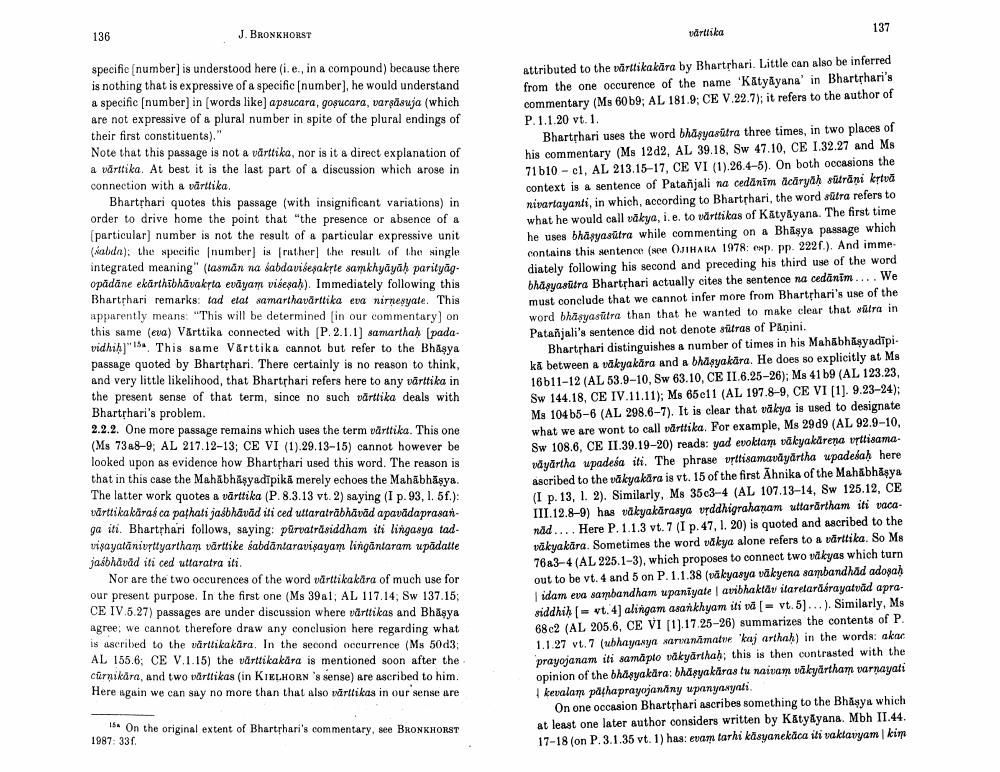Book Title: Archiv Fur Indische Philosophie Author(s): Johannes Bronkhorst Publisher: Johannes Bronkhorst View full book textPage 8
________________ 136 J. BRONKHORST drttila 137 specific (number) is understood here (ie, in a compound) because there is nothing that is expressive of a specific (number), he would understand a specific (number) in (words like) apsucara, gopucara, vargdauja (which are not expressive of a plural number in spite of the plural endings of their first constituents)." Note that this passage is not a varttika, nor is it a direct explanation of a varttika. At best it is the last part of a discussion which arose in connection with a varttika. Bharthari quotes this passage (with insignificant variations) in order to drive home the point that "the presence or absence of a (particular) number is not the result of a particular expressive unit (salda)the pocitie number is rather the result of the single integrated meaning" (lasman na sabdavidenakle sankhyayah parityag. opädane ekarthibhāvakta evāyam višepah). Immediately following this Bharthari remarks: tad etat samarthavirttika era nimenyate. This apparently means "This will be determined in our commentary) on this same (eva) Vårttika connected with (P. 2.1.1) samarthah padavidhi)" This same Varttika cannot but refer to the Bhagya passage quoted by Bhartphari. There certainly is no reason to think, and very little likelihood, that Bhartrhari refers here to any writika in the present sense of that term, since no such vårttika deals with Bharthari's problem. 2.2.2. One more passage remains which uses the term varttika. This one (Ms 7388-9; AL 217.12-13; CE VI (1).29.13-15) cannot however be looked upon as evidence how Bharthari used this word. The reason is that in this case the Mahabhasyadipika merely echoes the Mahabhagya. The latter work quotes a vārttika (P. 8.3.13 vt. 2) saying (1 p.93, 1. 5f.): udrttikakäras ca pathati jasbhavad ili ced uttaratrābhāvād apavddaprasanga iti Bharthari followe, saying: purvaträsiddham ili linganya tadvigayaliniurityartham vārttike sabdantaravisayam lingantaram upadalle jaśbhavad iti ced uttaratra iti Nor are the two occurences of the word värttikakära of much use for our present purpose. In the first one (Ms 39a1; AL 117.14, Sw 137.15; CE IV 5.27) passages are under discussion where vårttikas and Bhagya agree, we cannot therefore draw any conclusion here regarding what is ascribed to the värttikakara, In the second occurrence (Ms 50d3 AL 155,6; CE V.1.15) the varttikakira is mentioned soon after the cürnikara, and two varttikas (in KIELHORN 's sense) are ascribed to him. Here again we can say no more than that also vārtikas in our sense are attributed to the varttikakära by Bharthari. Little can also be inferred from the one occurence of the name 'Katyāyana' in Bharthari's commentary (Ms 60b9; AL 181.9; CE V.22.7); it refers to the author of P.1.1.20 vt. 1. Bharthari uses the word bhagyasūtra three times in two places of his commentary (Ms 12d2, AL 39.18, Sw 47.10, CE 1.32.27 and Ms 71 b10 - cl, AL 213.15-17, CE VI (1) 26.4-5). On both occasions the context is a sentence of Patanjali na cedanim acāryah surani krtva nivartayanti, in which, according to Bharthari, the word sutra refers to what he would call vākya, i.e. to virttikas of Katyāyana. The first time he uses bhäsyasutra while commenting on a Bhāsya passage which contains this sentence (see OJIHARA 1978: OHP. Pp. 2221.). And imme. diately following his second and preceding his third use of the word bhasyarltra Bharthari actually cites the sentence na cedanim... We must conclude that we cannot infer more from Bharthari's use of the word bhasyaslitra than that he wanted to make clear that dira in Patanjali's sentence did not denote sutras of Pāņini. Bharthari distinguishes a number of times in his Mahabhayadipi. ki between a vakyakāra and a bhayakära. He does so explicitly at Ms 16b11-12 (AL 53.9-10, Sw 63.10, CE IL 6.25-26). Ms 41 b9 (AL 123.23, Sw 144.18, CE IV.11.11); Ms 65c11 (AL 197.8-9, CE VI [1]. 9.23-24): Ms 104b5-6 (AL 298.6-7). It is clear that vakya is used to designate what we are wont to call drttika. For example, Ms 2949 (AL 92.9-10, Sw 108.6, CE IL.39.19-20) reads: yad evoktam vākyakarena utisama dyartha upadesa iti. The phrase uttisama dyartha wpadekah here ascribed to the takyakára is vt. 15 of the first Ahnika of the Mahabhişya (I p. 13, 1. 2). Similarly, Ms 35c3-4 (AL 107.13-14, Sw 125.12, CE III. 12.8-9) has väkyakarasya upddhigrahanam uttarartham iti vacanad.... Here P. 1.1.3 vt. 7 (I p. 47, 1. 20) is quoted and ascribed to the vükyakara. Sometimes the word vakya alone refers to a vürttika. So Ms 76a3-4 (AL 225.1-3), which proposes to connect two udkyas which turn out to be vt. 4 and 5 on P. 1.1.38 (udkyasya vakyena sambandhad adopah idam ena sambandham tupaniyale avibhaktdv itaretardárayatudd aprasiddhih - wt. 41 alingam asarikhyam iti va [- vt. 5)...). Similarly, Ms 68c2 (AL 205.6, CE VI (1).17.25-26) summarizes the contents of P. 1.1.27 vt. 7 (ubhayanya sarunimate 'kaj arthah) in the words: akac prayojanam iti samapto vákyarthah, this is then contrasted with the opinion of the bhasyakara: bhagyakaras tu naivam vakartham warnayati kevalam pathaprayojaniny upanyynti. On one occasion Bharthari ascribes something to the Bhagya which at least one later author considers written by Katyāyana. Mbh II.44. 17-18 (on P.3.1.35 vt. 1) has: evam tarhi käsyanekaca iti vaktavyamkim 18 On the original extent of Bharthari's commentary, see BRONKHORST 1987: 33f.Page Navigation
1 ... 6 7 8 9 10 11 12 13
